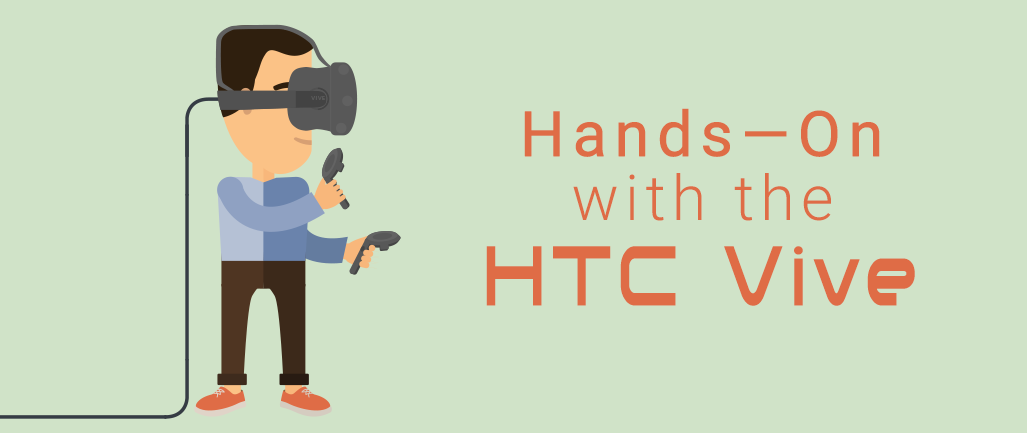
A few months ago, I detailed the different virtual reality headsets coming to the market in 2016. Thanks to a timely birthday/Father’s Day combo (thanks, kids!), I was able to get my hands on an HTC Vive kit to do my own hands-on testing. What I’ve found makes me more certain than ever that VR is a game changer going forward in a number of different areas.
The Vive Experience
Setting up the Vive was straightforward. Everything about the packaging was solid, and the pieces were easy to set up and configure. The system does require two small black boxes (called “Lighthouses”) to be attached at the corners of the play space, but they’re definitely worth the effort. Through the Lighthouses, the Vive is able to not only sense the direction of the headset, but also its placement in the space. This means that interaction is no longer limited to simply 360 degrees of world, but that you can step through, crouch, and jump as needed in the space.
Of course, few of us have an entire room in our houses to set aside for such things, so I’ve made do with a smaller space, earned a few bruises from the dining room furniture, and inspired the hasty relocation of a glass cabinet. (The Vive does include a feature that warns you when you’re reaching the limits of the play area, but I always seem to notice it too late …)
Virtual Reality
With the Vive (and presumably the Oculus and Playstation VR), virtual reality has finally come into its own. While many of the experiences presently available are little more than tech demos, there’s enough to experience to provide some insight into the potential.
As an example, one particular experience had me appear in the middle of a rickety bridge over an immense chasm. I reflexively crouched to maintain my balance, causing several small stones to fall over the side of the bridge, echoing the whole way down. Even though I knew that the experience was entirely virtual and that I was, in reality, safely in my dining room, I had to briefly take the headset off to confirm the existence of the floor before I could force myself to step off the bridge. Although nothing bad happened, the immersion of the experience was near total.
The Potential
Obviously, the entertainment possibilities of these products are immense. A whole new realm of virtual experiences is available to us, and it’s going to expand quickly. The challenge will be the tension between the big, immersive experiences needed to convince non-geeks to invest in the VR experience, while at the same time trying to convince studios and developers to create those experiences for what’s initially a very small install base. The technology will no doubt trickle out, though, and in several years the average home user will have access to some form of VR device.
On the educational side, the potential here is fascinating. What would it be like, I wonder, to be able to create immersive simulations or recreations of historical events, allowing the student to appreciate the living, breathing history of our world in a new way.
At the same time, though, I’m concerned that the nature of any recreation is that there are inaccuracies, and the more immersive the experience the more likely the details are to stick, accurate or not. There’s some incredible potential here, though, for allowing students to simulate different scenarios in training without the risks that such practice might pose in the real world. On some level, the educational applications will be limited by the resources available for development, but the rise of 360 video and the rapid creation of tools for content creation makes one wonder what possibilities exist going forward.
The Peril
The concerns I voiced in my first article on VR remain. Virtual reality is not reality, but it comes close enough to begin to be mistaken for it. It’s easy to forsee that as technology advances, we will live in a world where significant potential exists to delude oneself into thinking the VR realm is reality. That’s an extreme case, but the lesser version of it, wherein we significantly shift our cultural experience of what is real to a (somehow even more) subjective version of reality, is definitely a concern.
Consider how our view of significant relationships has shifted with the rise of social media to create new connections. Those connections may not be as deep or immersive as traditional friendships (it’s easier to manage impressions online), but they’re nonetheless real relationships. VR may not be reality, but it’s nonetheless real, or so the argument goes.
I also don’t believe for a moment that the VR world will be immune to the same content challenges that have plagued mankind from Day 1. The first use for any new technology is often either military or pornographic in nature, and VR will be no exception. Articles already abound on the new frontier in VR pornography, and the immersive nature of the medium will only make this phenomenon more toxic to healthy relationships.
Looking Ahead
Let’s not, however, throw out the baby with the baptismal water, so to speak. Abuse does not negate fair use. There’s a lot of potential in this new communication medium, but it falls to us as individuals, geeks, congregations, and church bodies to find the resources to create compelling content that communicates the Gospel to a generation growing up in a brave, new world.
Subscribe to this blog, Technology & Your Ministry, to receive notifications about future content like this!
























